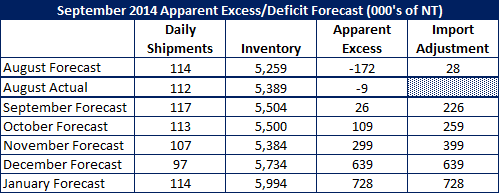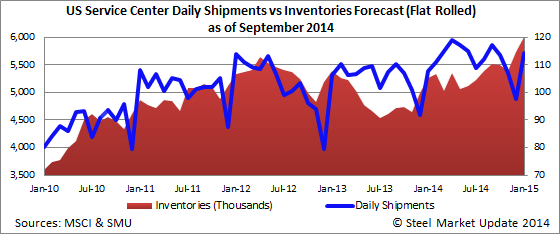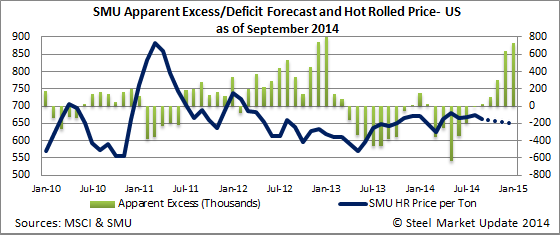SMU Data and Models

Service Centers Essentially Eliminate Apparent Inventory Deficit
Written by Brett Linton
September 19, 2014
Steel Market Update nailed (in our opinion) last month’s forecast for August. We projected that the -193,000 tons deficit from the end of July (based on our proprietary formula for what a balanced flat rolled inventory level should be for the U.S. service centers) would be eliminated and move into a very small excess situation. This was due to an import adjustment that we made to inventory levels of 200,000 tons. The actual excess/deficit level for August was -9,000 tons which is pretty darn close to perfect when you are playing with large numbers.
Our new forecast is calculated using September 2013 through January 2014 figures, increasing daily shipments by 6 percent and inventory levels by 5 percent. We estimate that inventories will move further into an excess state throughout 2014. Note that we have added additional foreign tonnage to inventories for September, October and November by 200M, 150M and 100M, respectively. However, we believe there will need to be an inventory adjustment which would come out of domestic tonnages prior to the end of the year lead times (thus we will need to remove our domestic inventory growth levels probably in December). We will watch this carefully in the coming weeks.
An adjustment in domestic order patterns would probably result in downward pressure on spot pricing. We think there is a better than 50/50 odds that 2014 will return to normal 4th Quarter buying patterns when special price offers are made by the domestic mills to fill their Thanksgiving through New Year’s order books.
Below is a model showing our daily shipment forecast rates and inventory levels through January 2015.
Below is a graphic showing our apparent excess model with a hot rolled price forecast overlay.

Brett Linton
Read more from Brett LintonLatest in SMU Data and Models

SMU Scrap Survey: Sentiment Indices rise
Both current and future scrap sentiment jumped this month, though survey participants reported responses before key trade news was announced.

SMU Survey: Sentiment splits, buyers have better view of future than the present
SMU’s Steel Buyers’ Sentiment Indices moved in opposite directions this week. After rebounding from a near five-year low in late June, Current Sentiment slipped again. At the same time, Future Sentiment climbed to a four-month high. Both indices continue to show optimism among buyers about their company’s chances for success, but suggest there is less confidence in that optimism than earlier in the year.

SMU scrap market survey results now available
SMU’s ferrous scrap market survey results are now available on our website to all premium members. After logging in at steelmarketupdate.com, visit the pricing and analysis tab and look under the “survey results” section for “ferrous scrap survey” results. Past scrap survey results are also available under that selection. If you need help accessing the survey results […]

SMU flat-rolled market survey results now available
SMU’s latest steel buyers market survey results are now available on our website to all premium members. After logging in at steelmarketupdate.com, visit the pricing and analysis tab and look under the “survey results” section for “latest survey results.” Past survey results are also available under that selection. If you need help accessing the survey results, or if […]

SMU Survey: Sheet lead times stabilize, plate contracts
Mill lead times for sheet products were steady to slightly longer this week compared to our late June market check, while plate lead times contracted, according to steel buyers responding to this week’s market survey.



